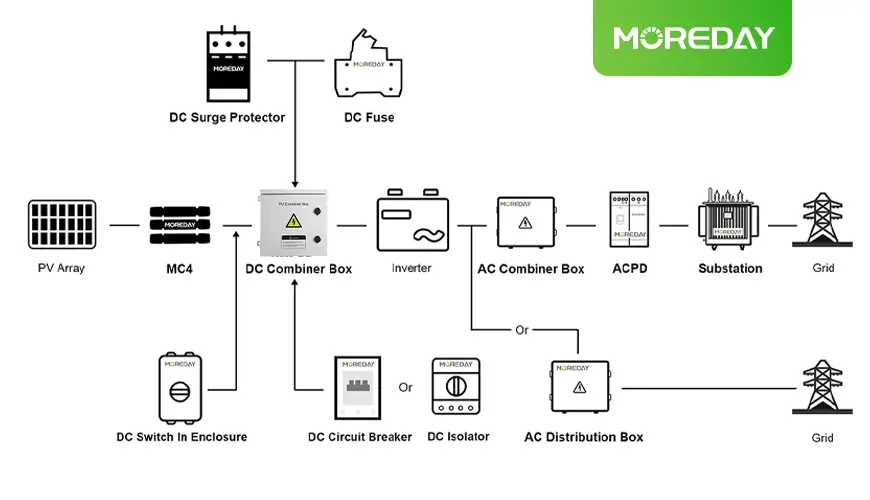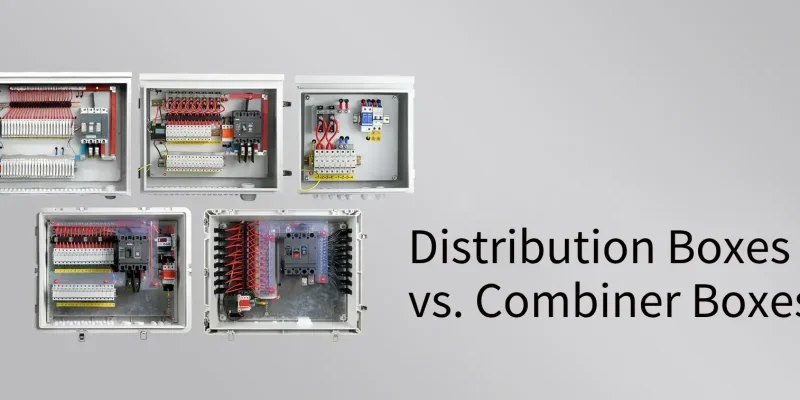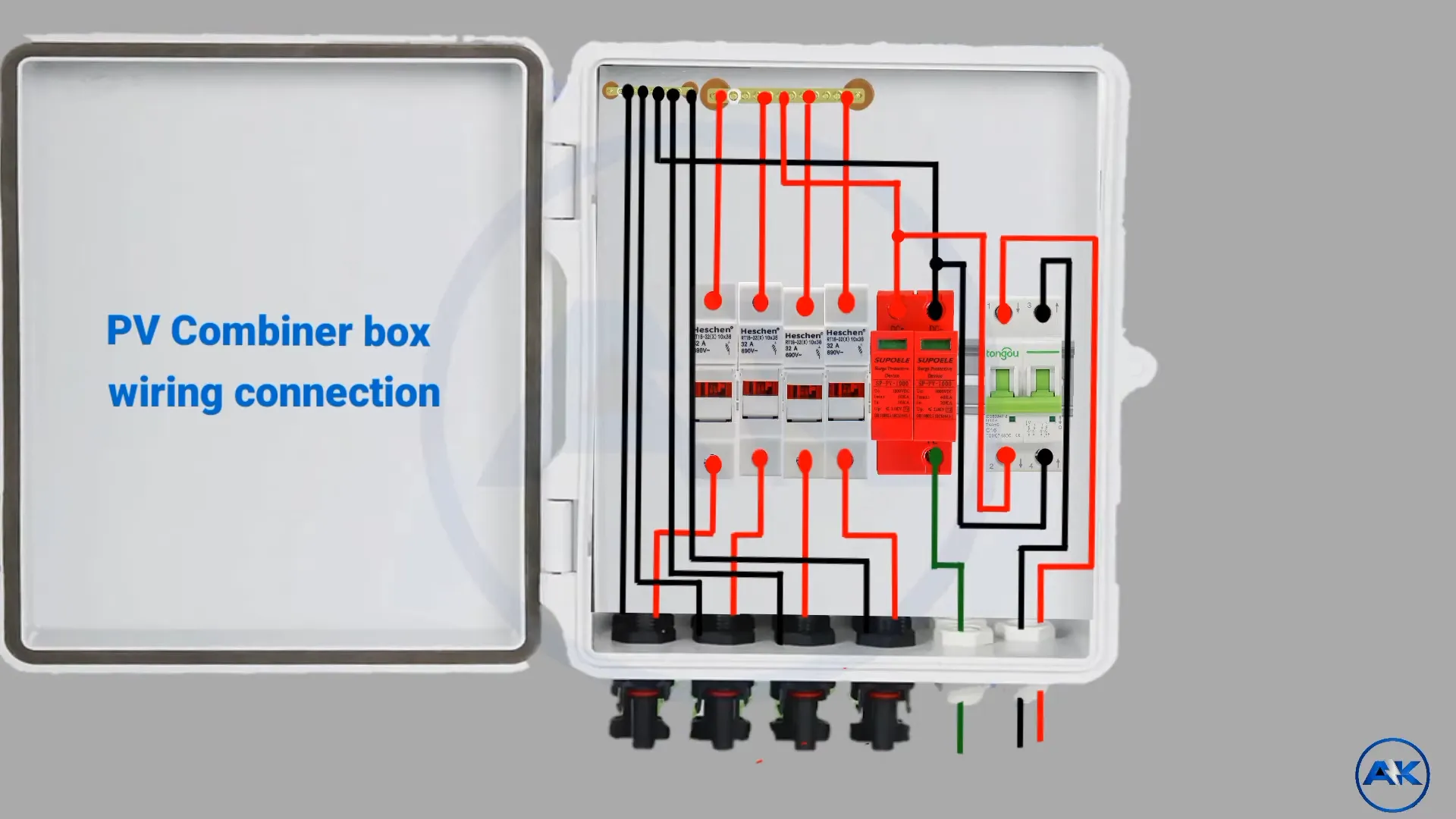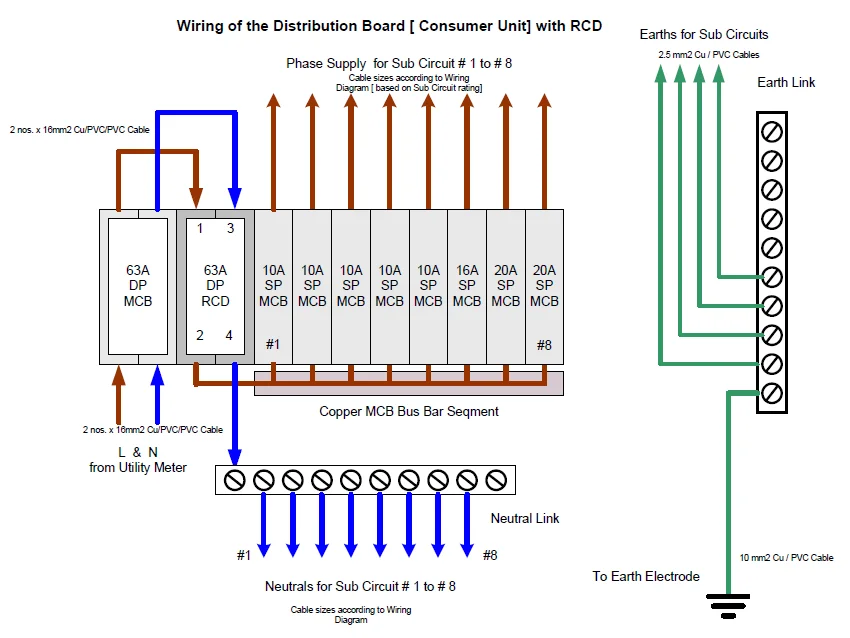はじめに
電気システム、特に太陽光発電(PV)設備では、配電ボックスとコンバイナーボックスの違いを理解することが重要です。どちらも重要な役割を果たしますが、それぞれ異なる機能に合わせて作られています。このブログでは、それぞれのボックスの役割、構成部品、用途、主な違いについて説明します。

クレジット モーデー
配電ボックスを理解する
A 配電ボックス は、単一の電源から複数の回路に電力を分配するための中心点です。安全な電力管理を保証し、過負荷を防止するためのサーキット・ブレーカーやヒューズなどの保護素子を備えています。ここでは、その特徴と用途について詳しく見ていきます:
機能性
配電ボックスは、ビルや施設内のさまざまな回路に電力を分配するように設計されており、安全な運用を確保するために故障に対する保護を提供します。
コンポーネント
典型的な配電ボックスには
- サーキットブレーカー 過負荷や短絡から各回路を保護する。
- ヒューズ: 故障条件下で回路を遮断することで、さらなる保護を提供する。
- サージ保護装置: 電圧スパイクからの保護。
アプリケーション
これらの箱は広く使われている:
- 居住環境: 家庭用電気システムを安全に管理する。
- 商業的な設定: オフィスビルや店舗で効率的に電力を分配します。
- 産業用セッティング: 重機や機器の適切な電源管理を行う。
デザイン
配電ボックスは屋内・屋外両用に設計されており、屋外用にはさまざまな環境条件に耐える耐候性エンクロージャーを備えています。
コンバイナー・ボックスを理解する
A コンバイナーボックス は、特にソーラー・エネルギー・システムで使用され、複数のソーラー・パネルまたはインバーターからの出力を1つの出力に統合します。これにより、配線が簡素化され、システム全体の安全性が向上します。主な特徴は以下の通りです:
機能性
コンバイナーボックスは、複数のソーラーパネルまたはインバーターのDCまたはAC出力を1つの出力ラインにまとめ、インバーターまたは送電網に供給する。
コンポーネント
一般的なコンバイナーボックスには以下のものが含まれる:
- ヒューズまたはサーキットブレーカー: 各入力ストリングに保護を提供する。
- サージ保護装置: 電圧スパイクから保護する。
- 監視装置: パフォーマンスを追跡するために含まれることもある。
アプリケーション
主に太陽光発電システムで使用されるコンバイナーボックスは、複数ストリングのソーラーパネルを効率的かつ安全に管理・整理するために不可欠です。
デザイン
コンバイナーボックスは多くの場合、IP65以上の耐候性を持つように設計されており、一般的にソーラーパネルが設置される屋外条件に適しています。
配電ボックスとコンバイナー・ボックスの比較
| 側面 | ディストリビューション・ボックス | コンバイナーボックス |
|---|---|---|
| 主要機能 | 複数の回路に電力を分配 | 複数のソーラーパネルやインバーターからの出力を1本のラインにまとめる |
| 代表的なコンポーネント | サーキットブレーカ、ヒューズ、サージ保護装置 | 各ストリング用のヒューズまたはサーキットブレーカー、サージ保護、場合によっては監視装置 |
| 使用状況 | 住宅、商業施設、工業施設など、一般的な電気システムに使用される | 特に太陽光発電システムに使用され、配線工程を合理化し、安全性を確保する。 |
| 保護メカニズム | 各回路への過負荷から保護 | ソーラーパネル設置における過電流とサージからの保護 |
| 設置場所 | 屋内および屋外設置に適し、屋外使用には耐候性が必要な場合が多い | 主にソーラーパネル・アレイの近くに屋外設置され、環境問題に耐えられるよう設計されている。 |
設置の複雑さの比較
配電ボックスとコンバイナーボックスを比較する場合、設置の複雑さは考慮すべき重要な要素です。ここでは、それぞれの設置上の注意点を説明します:
- 配電ボックスの設置:
- 部品や配線方法が標準化されているため、一般的に取り付けが簡単
- 通常、屋内に設置され、ユーティリティルームや地下室に設置されることが多い。
- 適切な接地と地域の電気工事規定への準拠が必要
- 電気系統の複雑さによっては、専門家による設置が必要な場合がある。
- コンバイナーボックスの設置
- 特に大規模ソーラーシステムでは、設置プロセスがより複雑になる
- 屋外に設置されることが多く、耐候性のあるエンクロージャーが必要
- 複数のソーラーパネル・ストリングを接続する必要があるため、複雑な作業が必要となる。
- 配線の引き回しや管理を綿密に計画する必要がある
- サージ保護装置や監視システムなどの追加コンポーネントが含まれる場合があります。
- 共通の配慮:
- どちらも、識別と保守を容易にするために、回路に適切なラベルを付ける必要があります。
- 設置の複雑さは、どちらのタイプのボックスでも、システム・サイズとともに増大する。
- 特に太陽光発電設備のコンバイナーボックスでは、過熱を防ぐために適切な換気が重要である。
- システム全体への影響:
- コンバイナーボックスは、太陽光発電設備における配線の複雑さを大幅に軽減し、全体的な設置コストを削減できる可能性があります。
- 配電ボックスは、ビル内の電気システムの将来の拡張を簡素化します。
- どちらのタイプのボックスも、正しく設置されれば、システムの効率と安全性に貢献します。
従来の電気システムでは、配電ボックスの設置は一般的に簡単だが、コンバイナーボックスは太陽光発電システムでの役割のため、より専門的な知識が必要となる。コンバイナーボックスの設置の複雑さは、大規模な太陽光発電の設置を合理化し、システムの性能を向上させるその能力によって相殺される。
コンバイナーボックスワイヤー接続
もっと見る https://viox.com/solar-combiner-box-wiring-diagram/
配電ボックス配線図
もっと見るhttps://viox.com/distribution-box-and-selection-guide/
結論
まとめると、配電ボックスとコンバイナーボックスはどちらも電気的な接続を管理するために不可欠だが、その役割は大きく異なる。配電ボックスは、一般的な電気系統のさまざまな回路に電力を安全に分配するように設計されているのに対し、コンバイナーボックスは、太陽光パネルからの出力を集約してからインバータに送ることに特化している。これらの違いを理解することは、電気設備、特に太陽光発電システムの特定の要件に基づいて適切なデバイスを選択するために非常に重要です。適切なアドバイスと最適な選択のためには、専門家に相談することをお勧めします。





